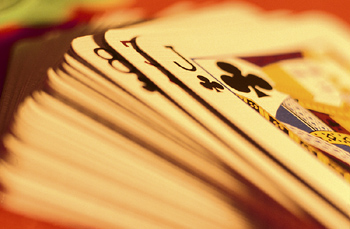Baccarat Strategy
A COUNTING FORMULA - PART TWO
 Unlike the game of blackjack, where "plus" means something good for us, we are not necessarily looking for one side or another to be biased, so it doesn't much matter which one we apply the plus or minus value to, but it might be better to use the Banker hand, when it wins, as a "minus" and the Player hand, when it wins, as a "plus" simply because we know ahead of time that the Banker hand is a higher percentage play to begin with. In other words, when a Player hand wins, you count a "plus-one."
Unlike the game of blackjack, where "plus" means something good for us, we are not necessarily looking for one side or another to be biased, so it doesn't much matter which one we apply the plus or minus value to, but it might be better to use the Banker hand, when it wins, as a "minus" and the Player hand, when it wins, as a "plus" simply because we know ahead of time that the Banker hand is a higher percentage play to begin with. In other words, when a Player hand wins, you count a "plus-one."
That tells you there is something positive for you, if you are a believer in the law of averages. Since there is supposed to be one more Banker bet per hundred that will win, when a Player hand wins that makes it all the more likely that a Banker hand will win next. Conversely, when the Banker hand wins off the top, you can count that as a "minus-one" because it makes the Player hand more likely. However, if you are looking for a "strike number," that is, a number at which you will increase your wager, you are looking for that number to get to a minus-two before considering that, since we know that a Banker win evens things out, so to speak.
Let's offer up something different, however, because any discrepancy in outcomes between the Player and Banker hands is going to be a positive for us. So why not just make it all positive? It might be easier for you to use a "P" to signify the Player hand, and "B" to describe the Banker hand, and when a Banker hand wins, for example, you are going to count "B1." If a Player hand win, you would count "P1." The strike number at which you would act on a Player hand is "B2," because of the 1% difference in average outcome between Banker and Player.
Then you would just continue forward, keeping a count as you go along. You'll progress to P2, then P3, P4, etc., keeping in mind that when you are in "P" territory that means you'll be placing your bets on the Banker hand, while when you are in "B" territory there is going to be more likelihood that the Player hands will win, so you would bet on the Banker hand. In other words, you will be betting the OPPOSITE of what letter the bias has moved toward. It may sound confusing, but once you practice it, this is the kind of thing that could become second nature to you.
The number tells you how many more hands have won between the Player and Banker. Of course, this difference will mean more depending on how many hands have been played. This is where the deck penetration comes into play. What you may want to do is divide the number by the number of decks remaining, to give you a better idea as to what the true picture is. Call it a "true count" if you will. So if the count is P8, and there are two decks remaining, the "true" count is P4. If there were six decks remaining in an eight-deck shoe, that true count would be only P1.5.
Of course, it is better to keep the count relative to the number of remaining decks rather than the number of hands played, because the divisor is a lot more manageable and gives you a better picture of how far you are penetrating a show, while the number of hands played could be dependent on a lot of factors, including how many players are at the table.
 Unlike the game of blackjack, where "plus" means something good for us, we are not necessarily looking for one side or another to be biased, so it doesn't much matter which one we apply the plus or minus value to, but it might be better to use the Banker hand, when it wins, as a "minus" and the Player hand, when it wins, as a "plus" simply because we know ahead of time that the Banker hand is a higher percentage play to begin with. In other words, when a Player hand wins, you count a "plus-one."
Unlike the game of blackjack, where "plus" means something good for us, we are not necessarily looking for one side or another to be biased, so it doesn't much matter which one we apply the plus or minus value to, but it might be better to use the Banker hand, when it wins, as a "minus" and the Player hand, when it wins, as a "plus" simply because we know ahead of time that the Banker hand is a higher percentage play to begin with. In other words, when a Player hand wins, you count a "plus-one."